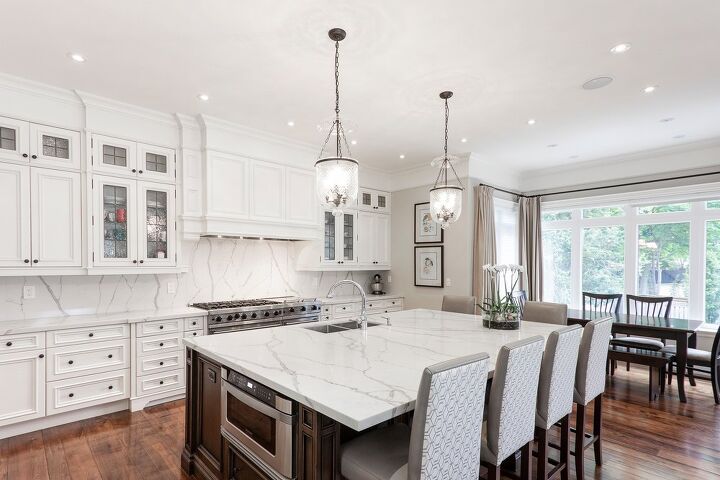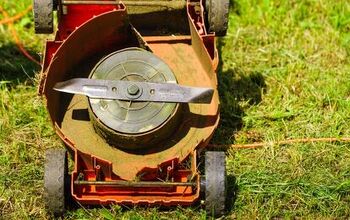5 Types Of Italian Marble (With Photos)

Undeniably, marble is a stunning natural stone that offers a classic look, timeless beauty, and unparalleled durability. Whether you’re looking for the ideal countertops for your kitchen or you want to upgrade your bathroom with marble tiles, there are numerous different types of marble available. In fact, marble is quarried from all over the globe and can be found on virtually every continent.
While there are a number of European countries that import marble, the most famous marble in the world comes from Italy – particularly the Carrara region. This is where the likes of Donatello and Michelangelo used Italian marble to craft some of the world’s most renowned works of art that have withstood the test of time.
Whether you’re someone who simply admires Italian marble or wants to install some in your own home, it’s important to know your options. The most common types of Italian marble are Carrara, Calacatta, and Statuario, with Botticino and Pavonazzo marble being other popular options. Let’s take a look at each of these in detail to understand their origins and unique characteristics.
Do You Need Countertop Installation Services?
Get free, zero-commitment quotes from pro contractors near you.

1. Carrara Marble
Carrara marble has a long history, dating back to the time of Ancient Rome. It takes its name from the city in which it is quarried in Italy, which is located on the northernmost tip of modern-day Tuscany, Italy. More specifically, Carrara marble comes from the Apuane mountains, which have over 600 quarry sites. It was used to create some of the most recognized buildings of Ancient Rome and sculptures of the Renaissance, most notably The Pantheon and Michelangelo’s David.
This type of marble has a white or blue-grey hue, with soft gray veins and, oftentimes, small hints of gold. Carrara marble is porous, meaning it requires a chemical treatment to be suitable for kitchen, bathroom, and any other applications where the marble will be exposed to water. It is also the most common type of marble, making it the most cost-effective as well. Carrara marble countertops generally cost roughly $40 a square foot.
Throughout Italy, and other locations throughout the world, Carrara marble continues to be used for everything from countertops and door jambs, to window sills and even street curbs. The notable uses and rich history of Carrara marble is what makes it one of the most sought-after types of marble.
2. Calacatta Marble
Another popular type of Italian marble, Calacatta marble is one of the rarer and more expensive varieties. In fact, this stunning, high-end natural stone also hails from Carrara Italy. However, the difference between it and Carrara marble is the thicker, more dramatic veining.
Calacatta marble features a distinguishable contrast between the white base and dark gray veins. This marble is also known to have gold and brown undertones. Calacatta marble is usually sold for around $180 a square foot. It is moderately porous, so, like Carrara marble, it requires a chemical treatment to be used in kitchens or bathrooms.
Because of its rarity and unique, bold appearance, Calacatta marble is typically associated with luxury. You’ll often find it in designer homes as vibrant backsplashes and kitchen and bathroom countertops. Though, its timeless appearance will look great on virtually any surface in your home.
3. Statuario Marble
Another rare Italian stone, Statuario marble is pure white with characteristic gray and gold veining throughout in a remarkable, bold pattern. This type of marble is a more exclusive natural stone and, like Carrara and Calacatta, is considered as one of the major white marbles. It is also quarried in the mountains above Carrara, Italy and encompasses only about 5% of the total marble that is quarried in this area. Today, Statuario marble remains in high demand and has limited availability.
As such, this stone is known to be the most precious marble in all of Italy. It is a great choice for indoor applications like backsplashes, floor tiles, vanities, and countertops. This marble is not suitable for exterior applications. Like all other options on this list, Statuario marble must be sealed prior to use. This will maintain the integrity of the stone and prevent the appearance of stains. In terms of pricing, Statuario marble is in the middle ground – costing an average of $50 per square foot.
4. Botticino Marble
Botticino marble, or Botticino Fiorito, gets its name from the town and municipality of the same name in Italy’s Brescia province where it is quarried. It has a very fine grain and beige color, oftentimes displaying gold accents. The base of Botticino marble is beige, but you’ll occasionally have darker colored veins, or white veins with signs of calcite.
This marble comes in many variations, which are distinguished by background uniformity, grain thickness, and the existence of more or less dark or white veins and calcite. The cost of Botticino marble varies based on the specific variation, but can range from $50 a square foot to as much as $150 per square foot installed.
Like all other stone surfaces, it’s important that Botticino marble is cared for properly. This includes sealing before use and using a daily cleaner that is specially formulated for use on marble.
5. Pavonazzo Marble
Pavonazzo marble is considered to be one of the many variations of Carrara marble. The name comes from the Italian word “pavone,” meaning peacock. It is characterized by the distinct coloring of the veins, which are usually either dark red or purple. Pavonazzo veining may also feature touches of blue or yellow as well.
This type of Italian marble has been used in a number of structures and construction projects throughout history. Most notably, Pavonazzo marble was used to form the railing in the first floor rotunda of the Belfast City Hall in Ireland. The cost of Pavonasso marble starts at approximately $120 per square foot.
Italian Marble Cost Comparison
For convenience sake, the following table outlines the average costs for the most common types of Italian marble:
| Type of Italian Marble | Average Cost |
| Carrara Marble | $40 to $80 per square foot |
| Calacatta Marble | $100 to $180 per square foot |
| Statuario Marble | $50 per square foot |
| Botticino Marble | $50 to $150 per square foot |
| Pavonazzo Marble | $120 per square foot |
Italian Marble Care and Maintenance
Regardless of what type of Italian marble you choose for your home, it’s important that you care for and maintain it appropriately. Oftentimes, what turns people off of marble is the fact that the material is easy to damage.
However, as long as you maintain your Italian marble properly, you won’t have to worry about etching, stains, or chipping. Here are some tips for keeping your Italian marble looking exceptional for as long as possible:
- Clean up spills quickly. Since marble is a carbonate, it has a negative reaction to acid. So, if you drop some orange juice on the surface, it’s possible for the marble to get permanently stained. The easiest solution is to always have a soft cloth on hand to remove any spills as soon as they occur.
- Avoid acidic cleaners. Using cleaners that have vinegar or citric compounds in them is the easiest way to damage marble countertops. In fact, when you see etching on marble, citrus-based cleaners are the most likely cause. Over time, the cleaners slowly erode away at the marble and yield a surface that is no longer smooth. Steer clear of vinegar or lemon, as they are commonly found in household cleaners.
- Clean with soap and water. Instead of using an acidic cleaning agent, all you need is a mild soap and warm water. Clean with gentle, straight strokes and a soft cloth. For more intense cleaning jobs, however, you can use a cleaner that is specially designed for use on marble surfaces.
- Seal your Italian marble. As marble is naturally porous, liquids can penetrate the surface. The best solution is to make sure the marble is sealed against staining prior to use. Then, it’s recommended that you reseal the marble every six months to one year. Though, there are ways to test when exactly it’s time to seal your marble.
Do You Need Countertop Installation Services?
Get free, zero-commitment quotes from pro contractors near you.

Why Italian Marble?
Many consider Italian marble to be superior, due to its durability, purity, and gorgeous white color. Additionally, the fact that so many buildings and art that was created centuries ago using Carrara marble are still standing is a testament to its longevity. The reason for Italian marble’s exceptional purity and durability is because of the way it is formed.
Marble is essentially crystallized limestone. When the limestone gets hit with high pressure and high temperature, large crystals are created and bind together to form marble. This intense heat eliminates a lot of the purities in the stone and what’s left behind is sections of white marble with colored veins running through it.
Another reason why Italian marble is so sought-after is because of Italy’s rich stoneworking heritage. The Italians were the first to streamline and perfect the quarrying methods that are still in use today. They have incredibly high standards for quality control and everything is done with immense precision. In fact, Italians are still revered as some of the most accomplished cutters and carvers in the stone industry today.

Jessica considers herself a home improvement and design enthusiast. She grew up surrounded by constant home improvement projects and owes most of what she knows to helping her dad renovate her childhood home. Being a Los Angeles resident, Jessica spends a lot of her time looking for her next DIY project and sharing her love for home design.
More by Jessica Stone































